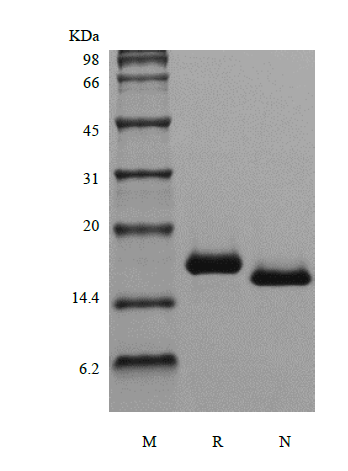- Synonyms
- Flt3L, SL Cytokine
- Source
- Escherichia coli.
- Molecular Weight
- Approximately 17.6 kDa, a single non-glycosylated polypeptide chain containing 155 amino acids.
- Size
- 10µg/ 100µg/ 500µg/ 1mg
- AA Sequence
- TQDCSFQHSP ISSDFAVKIR ELSDYLLQDY PVTVASNLQD EELCGGLWRL VLAQRWMERL KTVAGSKMQG LLERVNTEIH FVTKCAFQPP PSCLRFVQTN ISRLLQETSE QLVALKPWIT RQNFSRCLEL QCQPDSSTLP PPWSPRPLEA TAPTA
- Purity
- > 97 % by SDS-PAGE and HPLC analyses.
- Biological Activity
- Fully biologically active when compared to standard. The ED50 as determined by a cell proliferation assay using human AML5 cells is less than 1.0 ng/ml, corresponding to a specific activity of > 1.0 × 106 IU/mg.
- Physical Appearance
- Sterile Filtered White lyophilized (freeze-dried) powder.
- Formulation
- Lyophilized from a 0.2 μm filtered concentrated solution in PBS, pH 7.0.
- Endotoxin
- Less than 1 EU/μg of rHuFlt3-Ligand as determined by LAL method.
- Reconstitution
- We recommend that this vial be briefly centrifuged prior to opening to bring the contents to the bottom. Reconstitute in sterile distilled water or aqueous buffer containing 0.1 % BSA to a concentration of 0.1-1.0 mg/mL. Stock solutions should be apportioned into working aliquots and stored at ≤ -20 °C. Further dilutions should be made in appropriate buffered solutions.
- Stability & Storage
- Use a manual defrost freezer and avoid repeated freeze-thaw cycles.
- 12 months from date of receipt, -20 to -70 °C as supplied.
- 1 month, 2 to 8 °C under sterile conditions after reconstitution.
- 3 months, -20 to -70 °C under sterile conditions after reconstitution.
- Usage
- This material is offered by Shanghai PrimeGene Bio-Tech for research, laboratory or further evaluation purposes. NOT FOR HUMAN USE.
- SDS-PAGE

- Reference
- 1. Hacein-Bey S, Basile GD, Lemerle J, et al. 1998. Blood, 92: 4090-7.
2. Peters M, Solem F, Goldschmidt J, et al. 2001. Exp Hematol, 29: 146-55.
3. Beq S, Fontanet A, Theze J, et al. 2004. AIDS, 18: 2089-91.
4. Mahadevan D, Choi J, Cooke L, et al. 2009. Hum Genomics Proteomics, 2009: 453634.
- Background
- Flt3-ligand (FL) is a recently identified hematopoietic cytokine whose activities are mediated by binding to the transmembrane glycoprotein Flt3. Flt3 was first discovered as a member of the class III subfamily of receptor tyrosine kinases (RTK) whose expression among hematopoietic cells was found to be restricted to highly enriched stem/progenitor cell populations. Additionally, class III RTKs include the receptors from SCF, M-CSF and PDGF. Not surprisingly, Flt3-ligand is also structurally related to M-CSF and SCF. All three cytokines have been shown to exist both as type I transmembrane proteins and as soluble proteins. The predominant human FL isoform is a transmembrane protein that can undergo proteolytic cleavage to generate a soluble form of the protein. An alternatively-spliced FL mRNA, encoding a soluble form of the human FL, has also been identified. FL is widely expressed in various human and mouse tissues. At the amino acid sequence level, human and mouse FL are approximately 72 % identical and the two proteins exhibit cross-species activity. FL has been shown to synergize with a wide variety of hematopoietic cytokines to stimulate the growth and differentiation of early hematopoietic progenitors.







 COA申请
COA申请
